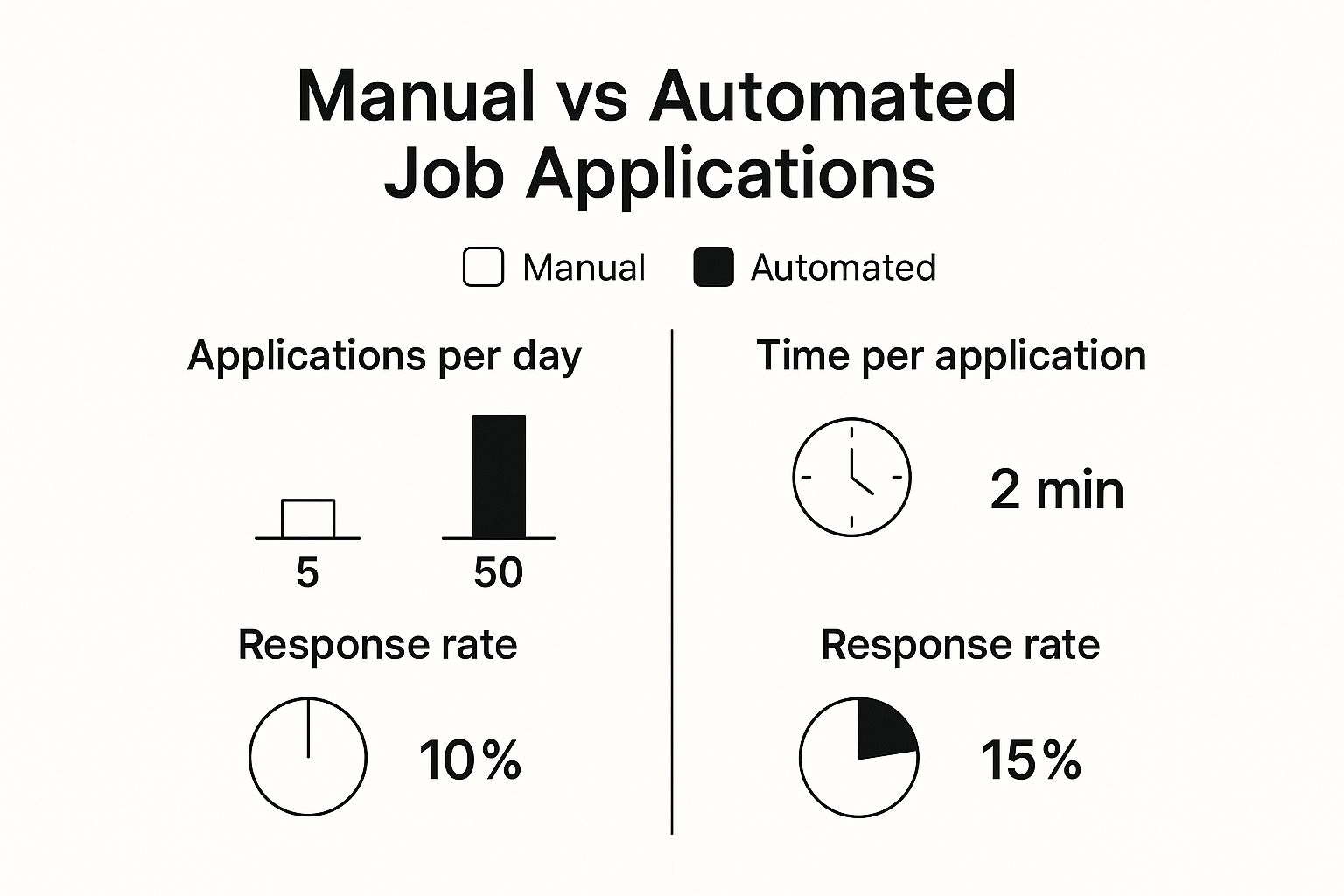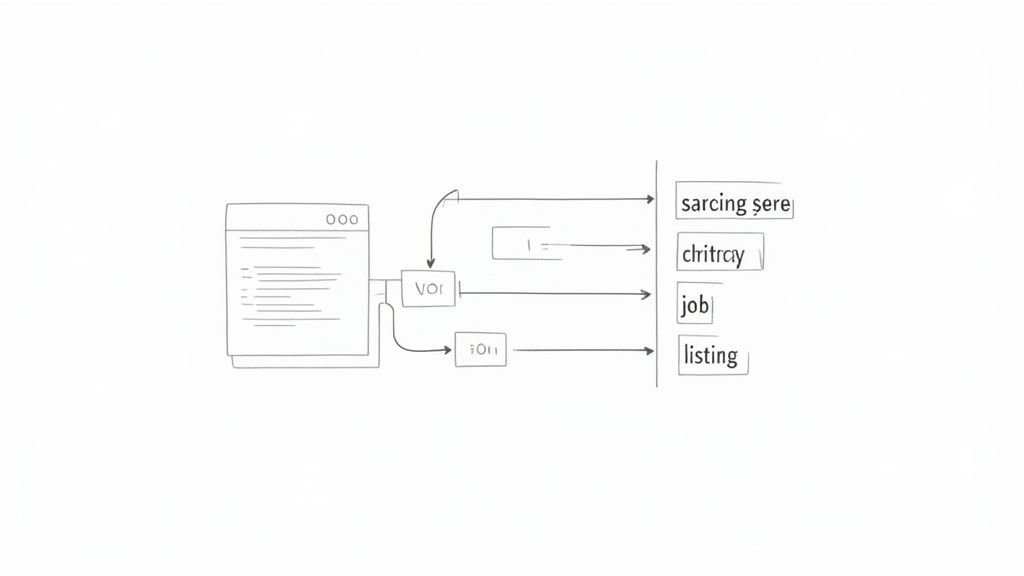
How to Automate Job Applications and Win Interviews
Tired of the endless cycle of finding a job, tweaking your resume, writing a cover letter, and filling out the same form fields over and over? If your job hunt feels like a second full-time job with terrible pay, you’re not alone. It’s a grind.
This high-effort, low-reward loop isn’t a sign that you’re unqualified. It’s a symptom of a fundamentally broken hiring process.
The Flaws in a Manual Job Search
Let’s be honest, the modern job search is a numbers game stacked against you. The biggest hurdle is just the sheer volume of competition. A typical corporate job post pulls in an average of 250 applications. Out of that massive pile, only four to six people will actually get an interview.
When recruiters are drowning in resumes, your carefully crafted application can easily get buried. It’s not personal; it’s just logistics. There simply isn’t enough time for a human to give every single application the attention it deserves.
The ATS Gatekeeper
On top of that, you have to get past the robots first. I’m talking about Applicant Tracking Systems (ATS). These are the software gatekeepers that most companies use to scan and filter resumes. They’re looking for specific keywords, skills, and formatting before a real person ever lays eyes on your application.
If your resume isn’t perfectly optimized for that specific system, you get filtered out. Poof. Gone. It doesn’t matter how experienced you are.
And these systems are only getting smarter. By 2025, it’s estimated that 79% of companies will be using AI or automation within their hiring software. While this tech can speed up the hiring process by as much as 60%, it also creates an incredibly precise filter that’s tough to get through consistently with a one-size-fits-all resume. You can dig deeper into how these systems operate over at SelectSoftwareReviews.com.
The core issue with the manual approach is that you’re playing a numbers game you can’t possibly win by hand. You just can’t generate the volume of high-quality, ATS-friendly applications required to compete.
This is where a change in strategy comes in. Automating your job applications isn’t about spamming every company on the internet. It’s about leveling the playing field. It directly tackles the biggest frustrations of the modern job search.
Here’s how it helps:
- Massive Reach: You can systematically apply to hundreds of relevant jobs, far more than you could ever manage manually.
- Beat the Bots: Automation tools are built to create applications that are designed to pass through ATS filters successfully.
- Get Your Time Back: Instead of wasting hours on repetitive data entry, you can focus on what really matters: networking, preparing for interviews, and brushing up on your skills.
By embracing automation, you stop fighting a losing battle against the system and start using its own rules to your advantage. It’s a strategic pivot from hoping you get noticed to ensuring you do.
Choosing Your Automation Toolkit
Picking the right platform to automate your job applications is probably the single most important decision you’ll make in this whole process. There are a ton of tools out there, but they really boil down to two different philosophies. Figuring out which one aligns with your own job search strategy is the key.
On one hand, you have the AI-only platforms. Think of these as the “spray and pray” option—built for pure speed and volume. They can fire off a massive number of applications in a flash, which can actually work well for entry-level jobs or roles where getting your name out there quickly is the main goal.
Then there are the hybrid services. These tools blend the raw power of AI with a crucial layer of human oversight. This “human-in-the-loop” model means you get the speed of automation, but a real person makes sure the final application is polished, well-targeted, and ready to beat the Applicant Tracking Systems (ATS).
AI Speed vs. a Human Touch
The real difference between these two approaches comes down to customization and quality control. Pure AI tools are great at applying to a high volume of jobs fast, but they can sometimes spit out generic-sounding resumes that don’t quite hit the mark.
Hybrid platforms, like Scale Jobs, use AI to do the heavy lifting but bring in human experts to tailor your resume for each specific role. They claim to handle up to 30 applications per day for each user, ensuring every single one is ATS-compliant and actually reads like a human wrote it.
This image really drives home just how much more efficient this process can be.

The numbers show it’s not just about saving a few hours. Automation can dramatically increase the number of applications you send, which naturally increases your chances of getting a response.
A hybrid service gives you a powerful middle ground. It stops you from sending out the generic, sometimes error-filled applications that a pure AI might produce. That human touch helps your resume get past the ATS bots and connect with an actual hiring manager.
Your Evaluation Checklist
Before you pull the trigger on any service, you need to vet it properly. The goal is to find a tool that genuinely fits your career stage, whether you’re fresh out of college or a senior executive. A good first step is to check out a rundown of the best AI tools for job seekers to get a feel for the landscape.
Here’s what I’d recommend looking for:
- Customization Depth: How much can you actually tweak the final application? Can you set specific rules for how the AI edits your resume, or is it just a one-size-fits-all deal?
- ATS Compatibility: Does the service specifically talk about making ATS-friendly resumes? You’re looking for features that mention keyword optimization and smart formatting that won’t get scrambled by the bots.
- Application Tracking: A solid tool will give you a dashboard to see where you’ve applied, check the status, and track response rates. Without this data, you’re just flying blind.
- Pricing and Value: Look at the cost versus what you get. Is it a monthly subscription, a one-time fee, or do you pay per application? Compare that to the number of applications and the level of human support involved.
Making the right choice here really sets the tone for your entire automated job search. The right tool won’t just be software; it’ll feel like a personal career agent, working around the clock to land you that next great role.
Building Your Master Resume for Automation

Before you can let any automation loose, you need to build your core asset. I like to call this the “master resume.” Think of it less like a traditional resume and more like a personal career database—a central brain holding every skill, project, and win you’ve ever had.
This document isn’t something you’ll ever send to a recruiter. It’s the raw material your automation tool will use to build tailored applications on the fly. Instead of a tight two pages, your master resume might be five, ten, or even more pages long. The more detail you feed the system, the smarter and more effective its customizations will be.
Structuring Your Master Document
Your first job is to stop thinking in terms of job descriptions and start thinking in terms of quantifiable results. Don’t just list what you were responsible for; spell out what you actually accomplished.
For instance, “Managed social media accounts” is vague. But “Increased social media engagement by 45% in six months by launching a new content strategy and A/B testing post formats” gives an AI something concrete to work with.
Organize this master document into clear, keyword-heavy sections. You want to make it as easy as possible for the software to find what it needs. I always recommend these components as a starting point:
- Expanded Experience Section: Under each job title, dump everything. Every project, every software tool you touched, and every metric you influenced. Bullet points are your best friend here.
- Comprehensive Skills Library: Don’t just lump them all together. Break them out into categories like Technical Skills (Python, SQL, AWS), Software (Salesforce, Figma, Asana), and Soft Skills (project management, negotiation, public speaking).
- Accomplishments and Awards: Log every single certification, award, or piece of recognition. Even if it seems minor, it could be the one detail that helps you stand out for a specific role.
The mantra here is “more is more.” Your AI needs a deep well of skills and accomplishments to draw from. A skimpy resume will only ever produce generic applications, which completely defeats the purpose of this whole exercise.
Feeding Your Profile to the AI
With your master resume complete, it’s time to upload all that rich information into your automation platform. This is where you lay down the rules of the game for your job search. You’ll set your target job titles, desired salary, industry preferences, and location—whether that’s fully remote or specific cities.
If you’re looking for help getting that initial document structured just right, using a free AI resume builder can be a huge time-saver.
Think of your profile as the AI’s instruction manual. By giving it a detailed and unambiguous dataset, you’re setting it up to find the best possible matches. From there, it can cherry-pick the perfect combination of skills and experiences to build a truly compelling application every single time, all while you’re doing something else.
Fine-Tuning Your Automated Job Search Filters

You’ve built your master resume. Now, it’s time to turn your automation tool from a wide net into a high-precision spear. This is where you lay down the ground rules and define exactly what a perfect role looks like for you. Simply plugging in a few keywords isn’t going to cut it; you need to think smarter.
The quickest way to level up your search is by using boolean operators. This sounds technical, but it’s a simple trick that dramatically improves your results by combining or excluding certain terms.
For instance, a search string like "Product Manager" AND "SaaS" NOT "Senior" instantly tells the system what you want and what you don’t want. You’re looking for PM roles in the software world, but you’re not ready for a senior position just yet. This single line can weed out hundreds of irrelevant jobs right from the start.
Going Beyond Basic Keywords
The real power of these platforms lies in their advanced filters. This is what separates a generic, scattershot approach from a targeted, professional one. Think of these settings as your personal gatekeeper, only letting the best opportunities through.
You want to create a search profile that’s specific enough to find the right roles but not so narrow that you miss out on great opportunities. Here are the filters I always recommend setting up first:
- Company Size: Are you a startup person who loves a small team (1-50 employees), or do you prefer the resources of a massive corporation (10,000+ employees)? Make that choice.
- Industry Focus: Don’t just say “tech.” Get specific. “Fintech,” “healthcare technology,” or “e-commerce” will align your search with your actual expertise.
- Negative Keywords: This is your secret weapon. Adding words like “manager,” “director,” or “intern” to your exclusion list prevents roles that are above or below your current level from ever hitting your inbox.
Layering these filters is like building a custom net that only catches the fish you’re actually interested in. It’s the difference between applying to 50 random jobs and 50 perfectly matched ones.
Activating Dynamic Customization
Here’s where things get really interesting. You can set up the AI to customize your resume and cover letter for each specific job. The system scans a job description, identifies the most important keywords, and then pulls the most relevant skills and accomplishments from your master resume to highlight.
Let’s say a job description asks for “data visualization” and “SQL.” The AI will spot those terms and automatically insert the bullet point from your master resume about that project where you used Tableau and SQL to boost reporting efficiency by 30%.
Suddenly, your application isn’t just another resume in the pile. It’s a direct response to what the hiring manager is looking for. This automated tweak makes every application feel custom-built, ensuring your most relevant qualifications are front and center every single time.
Keeping Score: How to Track and Optimize Your Automated Job Search

Getting your job bot up and running is a fantastic start, but the real magic happens next. To truly succeed, you have to think of your job search less like a one-off task and more like a strategic campaign—one that you’re constantly measuring and tweaking. Automation gets your resume seen, but analyzing the data is what gets you interviews.
The idea is to build a feedback loop. This turns your tool from a simple application machine into an intelligent partner that gets smarter with every resume it sends out. If you skip this part, you’re basically just throwing resumes into the wind and hoping for the best.
What to Measure: Your Key Performance Indicators
You can’t fix what you can’t see. Most automation tools have a built-in analytics dashboard, but honestly, a simple spreadsheet can do the trick too. The important thing is to consistently track the metrics that actually tell you if your strategy is working. For a much deeper look at this, check out our guide on building a powerful job application tracker.
To begin, focus on these critical numbers:
- Application-to-Response Rate: This is your north star. What percentage of your applications get any kind of human reply? This includes rejections, screening calls, and interview requests.
- Response Rate by Job Title: Are you getting more bites when you apply for “Marketing Manager” roles compared to “Digital Marketing Lead” positions? This tells you which titles you’re most competitive for.
- Resume Version Performance: If you’re testing different resume summaries or skill lists, which version is actually getting you more callbacks?
- Platform Effectiveness: Are you having more luck on LinkedIn than Indeed? Knowing this helps you focus your energy on the platforms that deliver.
This analytical approach is more important than ever. The job market is changing fast, largely because of AI. By 2030, some projections show that around 30% of current jobs in the U.S. could be automated, and 60% will be significantly reshaped by AI. Learning to use data to your advantage is how you stay ahead of the curve. You can find more fascinating AI job statistics at nu.edu.
Your automation tool gives you the numbers, but you provide the strategy. The real breakthroughs come from the insights you uncover, which guide your next moves and lead to more interview requests.
From Data to Action: Making Smart Changes
After you’ve collected a few weeks of data, it’s time to start making informed changes. Don’t just stare at the numbers—ask yourself why they look the way they do.
Is your response rate lower than you’d like? It might be time to experiment. Try rewriting the professional summary on your master resume, or maybe adjust your search filters to target a slightly different industry.
If you notice one version of your resume is a clear winner, make it your new go-to and start testing a new variation against it. This cycle of applying, measuring, and refining is the key to turning a good automated job search into a great one.
Common Questions About Automating Job Applications
Taking the plunge into automated job searching can feel like a big step, and it’s totally normal to have a few questions. To get the most out of these powerful tools, you need to understand not just the how, but also the why—including the ethics and best practices.
Let’s clear the air on some of the most common things people worry about.
Is It Unethical to Automate Job Applications?
Honestly, the ethics of this all come down to your approach. If your plan is to just blast out hundreds of applications for jobs you aren’t even remotely qualified for, you’re just creating more noise. That kind of spam makes hiring a nightmare for everyone involved and won’t do your reputation any favors.
But that’s not what smart automation is about.
When you use these tools to efficiently apply for well-matched positions that you’re genuinely a good fit for, it’s just a productivity hack. Think of it as a personal assistant for your job search. It handles the mind-numbing data entry so you can pour your energy into what actually matters: networking, preparing for interviews, and following up. The goal here is strategic efficiency, not just blind volume.
Can Recruiters Tell I Used an Automation Tool?
They absolutely can—if you’re using a cheap, clunky tool. The generic, error-riddled applications spit out by basic bots are a dead giveaway. They’re often the first to get tossed by an Applicant Tracking System (ATS) because they lack any real personalization and miss crucial keywords from the job description.
A sophisticated AI tool or a hybrid service, on the other hand, is a different story entirely. When you start with a strong master resume and set up thoughtful customization rules, the applications that come out the other side are practically indistinguishable from ones you’d spend an hour crafting by hand. In the end, what matters is the quality of the application, not how you got it there.
The biggest mistake is the ‘set it and forget it’ mindset. Automation is a powerful assistant, not a magic wand. True success requires active management and strategic thinking to guide the process.
What Is the Biggest Mistake to Avoid?
The most common trap I see people fall into is treating automation as a hands-off, magical solution. You can’t just flip a switch and expect job offers to start flooding your inbox. It just doesn’t work that way. For this to succeed, you have to stay in the driver’s seat.
This means you need to periodically check in on the jobs your tool is applying for. You have to monitor your response rates and be willing to tweak your strategy based on what the data is telling you. Automation takes the tedious form-filling off your plate, but it can’t replace the strategic thinking that a successful job hunt demands. Stay engaged, and make sure the tool is working for you, not against you.
How Do I Manage a High Volume of Recruiter Responses?
Getting more responses is a fantastic problem to have, but it’s a problem that requires a system. Without one, you’re going to drop the ball on promising opportunities, guaranteed.
Here’s a simple system to keep yourself organized:
- Create Email Filters: The first thing you should do is set up rules in your inbox to automatically funnel recruiter emails into a dedicated “Job Search” folder.
- Use a Simple Tracker: A basic spreadsheet or a Trello board is perfect for this. Log who you’ve talked to, interview schedules, and what the next steps are for each company.
- Prep Your Pitch: You never know when you’ll get an unexpected screening call. Have a concise “elevator pitch” about who you are and what you’re looking for rehearsed and ready to go.
Automation handles the initial outreach; your job is to be organized and ready to jump on the opportunities it creates.
Ready to stop the manual grind and start landing more interviews? Jobcamp uses AI to create custom, ATS-optimized resumes and cover letters in seconds, letting you apply to dozens of top jobs in minutes. Try it for free and see the difference.

